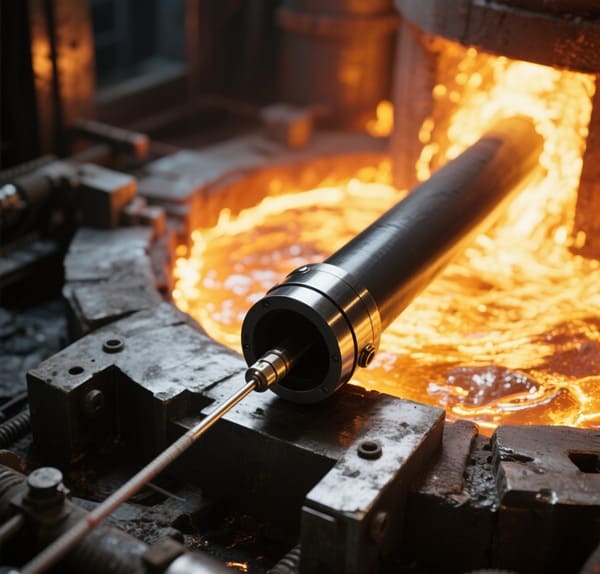Top Benefits of Silicon Nitride for High-Temperature Applications
Silicon Nitride (Si3N4) is an advanced ceramic material widely recognized for its exceptional properties in high-temperature environments. Combining excellent thermal stability, mechanical strength, and chemical resistance, Si3N4 offers unique advantages over traditional materials such as alumina, zirconia, and silicon carbide. This article explores the top benefits of silicon nitride in demanding applications like aerospace, automotive, energy, and electronics, supported by scientific data and practical comparisons to help engineers and manufacturers make informed decisions.
At Advanced Ceramic Hub, we specialize in high-quality silicon nitride ceramic, ensuring optimal performance for industrial and scientific applications.

What Is Silicon Nitride and Why Is It Important for High-Temperature Use?
Silicon Nitride is a covalently bonded ceramic compound of silicon and nitrogen, prized for its ability to maintain performance under extreme heat and stress. Its high melting point, low thermal expansion, and outstanding toughness make it suitable for components exposed to harsh thermal and mechanical loads. These features position Si3N4 as a preferred choice in industries requiring durable and reliable high-temperature materials.
Key Physical Properties of Silicon Nitride:
| Property | Value | Unit | Description |
| Density | ~3.2 | g/cm³ | Lightweight ceramic ideal for weight-sensitive parts |
| Melting Point | >1900 | °C | High melting point suitable for extreme heat |
| Thermal Conductivity | 20 – 30 | W/m·K | Efficient heat dissipation to prevent overheating |
| Thermal Expansion | 2.8 | 10⁻⁶/K | Low expansion reduces thermal stress and cracking |
| Hardness (Vickers) | 14 – 16 | GPa | High hardness for excellent wear resistance |
| Flexural Strength | 800 – 1000 | MPa | High mechanical strength to withstand loads |
| Fracture Toughness | 6 – 7 | MPa·m^0.5 | Superior toughness to resist crack propagation |
| Young’s Modulus | 300 – 320 | GPa | High stiffness to maintain shape under stress |
| Electrical Resistivity | >10¹⁴ | Ω·cm | Excellent electrical insulator |
| Specific Heat Capacity | 0.7 | J/g·K | Good capacity to absorb heat energy |
| Chemical Stability | Excellent | — | Resistant to oxidation and chemical attack |
Explore our high-quality silicon nitride ceramic.
How Does Silicon Nitride Perform Under Extreme Heat?
Si3N4 can withstand continuous use at temperatures above 1400°C while maintaining its mechanical integrity. Its low thermal expansion minimizes deformation, and its excellent thermal shock resistance allows it to survive rapid temperature changes without cracking. This combination is vital for applications like turbine engines, cutting tools, and high-temperature reactors.
Thermal Performance Comparison of High-Temperature Ceramics:
| Material | Max Use Temp (°C) | Thermal Expansion (10⁻⁶/K) | Thermal Shock Resistance | Typical Applications |
| Si3N4 | 1400 | 2.8 | Excellent | Aerospace, cutting tools |
| Al2O3 | 1600 | 8.0 | Poor | Insulators, wear parts |
| ZrO2 | 1200 | 10.5 | Excellent | Sensors, wear parts |
| SiC | 1600 | 4.0 | Moderate | Mechanical seals, abrasives |
What Mechanical Strength Benefits Does Silicon Nitride Offer at High Temperatures?
Silicon Nitride retains high flexural strength and fracture toughness even at elevated temperatures. Its wear resistance and fatigue strength make it ideal for components subjected to mechanical stress, including bearings, valves, and engine parts. This ensures longer service life and improved reliability under demanding conditions.
Mechanical Properties of Silicon Nitride:
| Property | Room Temp | 1000°C | Unit |
| Flexural Strength | 800-1000 | 600-800 | MPa |
| Fracture Toughness | 6-7 | 5-6 | MPa·m^0.5 |
How Silicon Nitride Excels in High-Temperature Chemical Resistance
In high-temperature environments, materials often face oxidation, corrosion, and chemical attack. Silicon Nitride’s strong covalent bonding provides excellent resistance against these factors, especially when exposed to steam, acids, or molten salts. This chemical stability helps maintain material integrity and performance over time, reducing maintenance and replacement costs.
| Material | Oxidation Resistance | Corrosion Resistance | Thermal Stability (Max Temp °C) | Common High-Temp Chemicals Resisted | Acid Resistance | Alkali Resistance | Notes |
| Si3N4 | Excellent | Excellent | >1400 | Steam, hydrochloric acid, sulfuric acid, molten salts, alkalis | Strong | Strong | Widely used as an insulator and wear-resistant layer |
| Al2O3 | Good | Excellent | ~1200 | Steam, hydrochloric acid, some acids | Strong | Moderate | Widely used as an insulator and a wear-resistant layer |
| ZrO2 | Moderate | Moderate | ~1300 | Limited resistance to acids and alkalis | Moderate | Low | Stabilized with Yttria to improve toughness |
| SiC | High | Good | ~1400 | Strong against oxidizing agents and molten metals | Moderate | Good | Excellent thermal shock resistance, used in seals |
How Does Silicon Nitride’s Thermal Shock Resistance Benefit Industrial Applications?
Thermal shock occurs when materials experience rapid temperature changes that induce stress and potential cracking. Silicon Nitride’s low thermal expansion and strong mechanical properties provide superior resistance to thermal shock compared to many other ceramics. This makes it invaluable for cyclic high-temperature processes like engines, furnaces, and cutting operations.
| Material | Critical Temperature Difference (°C) | Thermal Shock Resistance Description | Common Application Examples |
| Silicon Nitride (Si3N4) | 200–300 | Exceptional resistance to rapid temperature changes | Engine components, cutting tools, turbine parts |
| Alumina (Al2O3) | 50–100 | Moderate resistance, prone to cracking under thermal shock | Electrical insulators, wear parts |
| Zirconia (ZrO2) | 150–200 | Good thermal shock resistance due to transformation toughening | Thermal barrier coatings, sensors |
| Silicon Carbide (SiC) | 100–150 | Moderate resistance with high thermal conductivity | Mechanical seals, abrasives |
| Mullite | 100–150 | Good resistance, used in refractory applications | Kiln furniture, refractory linings |
What Manufacturing Techniques Optimize Silicon Nitride for High-Temperature Use?
Producing high-performance Si3N4 components involves powder synthesis, shaping, and sintering processes. Hot Isostatic Pressing (HIP) is commonly used to increase density and minimize defects, enhancing mechanical and thermal properties. Injection molding allows complex geometries with high throughput, while pressureless sintering is suitable for cost-effective bulk parts.
Common Manufacturing Processes:
| Process | Advantages | Typical Products |
| Hot Isostatic Pressing (HIP) | High density, fewer defects | Structural engine parts |
| Injection Molding | Complex shapes, high throughput | Precision components |
| Pressureless Sintering | Cost-effective mass production | Standard industrial parts |
In What High-Temperature Industries Is Silicon Nitride Most Widely Used?
Silicon Nitride’s unique combination of properties makes it a key material across several industries. In aerospace, it is used for turbine blades and engine parts; in automotive, for bearings and valves; in energy, for heat exchangers and gas turbines; and in electronics, for semiconductor substrates requiring high thermal stability.
Typical Industrial Applications:
| Industry | Application Examples | Key Benefits |
| Aerospace | Turbine blades, engine parts, heat shields | High thermal stability, lightweight, wear resistance |
| Automotive | Bearings, valves, turbocharger rotors, glow plugs | High toughness, thermal shock resistance, corrosion resistance |
| Energy | Heat exchangers, gas turbines, fuel cell components | Thermal conductivity, chemical stability, durability |
| Electronics | Semiconductor substrates, insulators, sensor housings | Electrical insulation, thermal stability, chemical resistance |
| Industrial Machinery | Cutting tools, mechanical seals, pump components | Wear resistance, toughness, thermal shock resistance |
| Medical Devices | Surgical tools, implant components | Biocompatibility, strength, corrosion resistance |
Request a custom quote for high-quality silicon nitride ceramic.
How Does Silicon Nitride Compare to Other High-Temperature Ceramics?
Compared to alumina, zirconia, and silicon carbide, silicon nitride offers a balanced combination of toughness, thermal shock resistance, and chemical stability. While alumina excels in chemical stability and silicon carbide in hardness, Si3N4 outperforms in mechanical toughness and resistance to thermal shock, making it ideal for many high-demand applications.
Comparison Summary:
| Material | Toughness (MPa·m^0.5) | Thermal Shock Resistance | Chemical Stability | Cost |
| Si3N4 | 6-7 | Excellent | Excellent | Moderate |
| Al2O3 | 3-4 | Poor | Excellent | Low |
| ZrO2 | 5-6 | Excellent | Moderate | High |
| SiC | 4-5 | Moderate | Good | Moderate |
What Future Trends Are Shaping Silicon Nitride Development?
Research on silicon nitride is focusing on nanoscale composites to improve toughness, additive manufacturing (3D printing) for complex geometries, and novel coatings to enhance surface properties. These innovations aim to expand its use in next-generation aerospace, energy, and electronics applications.
Future Development Trends:
- Nanoscale Si3N4 composites for enhanced mechanical properties
- Additive manufacturing enables complex, lightweight parts
- Advanced surface coatings for wear and corrosion resistance
- Integration into hybrid materials for multifunctional components
FAQ
| Question | Answer |
| Can silicon nitride be used in corrosive environments? | Yes, Si3N4 shows excellent resistance to many corrosive chemicals at high temperatures, including steam and acids. |
| How does silicon nitride compare to metals at high temperatures? | Si3N4 generally outperforms metals in thermal stability and oxidation resistance but has lower ductility. |
| Is silicon nitride machinable after sintering? | Machining is possible but challenging due to its hardness; diamond tools are typically required. |
| What industries commonly use silicon nitride? | Aerospace, automotive, electronics, and energy industries use Si3N4 for its heat resistance and mechanical strength. |
Conclusion
Silicon Nitride (Si3N4) stands out as a high-performance ceramic combining thermal stability, mechanical strength, and chemical resistance, perfectly suited for demanding high-temperature applications across multiple industries. Its ability to endure harsh conditions while maintaining integrity makes it an essential material for engineers and manufacturers aiming for reliability and longevity. As manufacturing technologies evolve, silicon nitride’s role will continue to grow in advanced aerospace, automotive, energy, and electronics applications. For those seeking expert resources and high-quality materials, Advanced Ceramics Hub provides comprehensive solutions and insights to support the expanding use of silicon nitride and other advanced ceramics.
Looking for high-quality silicon nitride ceramic? Contact us today!
